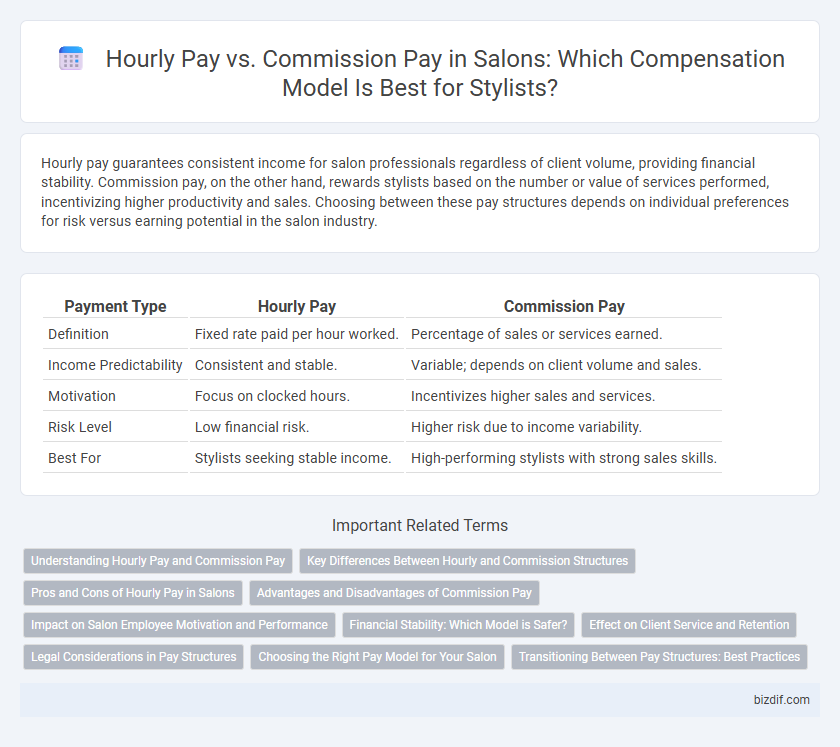Hourly pay guarantees consistent income for salon professionals regardless of client volume, providing financial stability. Commission pay, on the other hand, rewards stylists based on the number or value of services performed, incentivizing higher productivity and sales. Choosing between these pay structures depends on individual preferences for risk versus earning potential in the salon industry.
Table of Comparison
| Payment Type | Hourly Pay | Commission Pay |
|---|---|---|
| Definition | Fixed rate paid per hour worked. | Percentage of sales or services earned. |
| Income Predictability | Consistent and stable. | Variable; depends on client volume and sales. |
| Motivation | Focus on clocked hours. | Incentivizes higher sales and services. |
| Risk Level | Low financial risk. | Higher risk due to income variability. |
| Best For | Stylists seeking stable income. | High-performing stylists with strong sales skills. |
Understanding Hourly Pay and Commission Pay
Hourly pay in salons provides stylists with a fixed wage based on the number of hours worked, ensuring a steady income regardless of client volume. Commission pay allows stylists to earn a percentage of the revenue generated from their services, incentivizing higher productivity and quality. Understanding these payment structures helps both employers and employees balance financial stability with performance-driven rewards.
Key Differences Between Hourly and Commission Structures
Hourly pay in salons guarantees a fixed wage based on hours worked, providing financial stability regardless of client volume, while commission pay rewards stylists with a percentage of sales or services performed, directly linking income to individual performance. Hourly structures emphasize consistent earnings and predictability, suitable for employees prioritizing steady income, whereas commission models incentivize higher productivity and customer retention through variable, potentially higher earnings. Salon owners must balance these pay structures to motivate staff effectively and maintain operational costs.
Pros and Cons of Hourly Pay in Salons
Hourly pay in salons offers consistent income and financial stability, making it ideal for stylists who prefer predictable earnings regardless of client volume. However, this pay structure may limit earning potential compared to commission-based models, especially during high-demand periods when stylists could earn more by receiving a percentage of service fees. Additionally, hourly wages can reduce motivation to increase client bookings or upsell services, potentially impacting overall salon revenue.
Advantages and Disadvantages of Commission Pay
Commission pay in salons offers stylists the advantage of earning income proportional to their productivity, incentivizing higher performance and customer satisfaction that can lead to increased tips and repeat business. However, commission-based pay may result in income instability due to fluctuating client volume and seasonal demand, which can create financial uncertainty for salon professionals. This model might also encourage prioritizing quick services over quality to maximize commissions, potentially impacting overall client experience.
Impact on Salon Employee Motivation and Performance
Commission pay directly ties compensation to sales, often boosting motivation for salon employees by rewarding their individual performance and customer engagement. Hourly pay offers stability and can reduce stress, but may limit incentives for upselling or exceptional service. Combining both models can balance motivation and financial security, leading to improved overall employee performance in the salon industry.
Financial Stability: Which Model is Safer?
Hourly pay offers more financial stability for salon employees by providing a guaranteed income regardless of client volume, ensuring consistent cash flow to cover living expenses. Commission pay relies heavily on the number of clients serviced and sales made, causing income fluctuations that may lead to financial uncertainty during slower periods. For salon professionals prioritizing steady earnings and budgeting ease, hourly pay is generally the safer compensation model.
Effect on Client Service and Retention
Hourly pay in salons often promotes consistent client service by ensuring stylists receive steady income regardless of sales volume, encouraging focus on quality and customer satisfaction. Commission pay motivates stylists to increase sales and upsell services, which can enhance client offerings but may risk prioritizing revenue over personalized care. Balancing both pay structures can optimize stylist performance, fostering client retention through high-quality, attentive service alongside effective service promotion.
Legal Considerations in Pay Structures
Legal considerations in salon pay structures mandate compliance with minimum wage laws and overtime regulations for both hourly and commission-based employees. Salons must ensure transparent documentation of commission agreements to avoid wage disputes and adhere to state-specific labor laws governing tip pooling and deductions. Failure to comply with these regulations can result in legal penalties and damage to the salon's reputation.
Choosing the Right Pay Model for Your Salon
Choosing the right pay model for your salon involves evaluating factors such as employee motivation, budget constraints, and service diversity. Hourly pay offers stability and consistent income, ideal for team cohesion and predictable scheduling, while commission pay incentivizes performance and drives sales growth by rewarding stylists based on client bookings and product upsells. Balancing these models can optimize staff satisfaction and profitability, promoting a thriving salon environment.
Transitioning Between Pay Structures: Best Practices
When transitioning between hourly pay and commission pay in a salon, clear communication about the new compensation structure is essential to ensure staff understanding and morale. Implementing a gradual phase-in period allows stylists to adjust their financial expectations while maintaining stability. Tracking performance metrics and providing regular feedback help align employee goals with salon profitability during the transition.
Hourly Pay vs Commission Pay Infographic

 bizdif.com
bizdif.com